|
| |
|
From a Bare
Hull: The Deck
(Page 6)
|
Fiberglassing the Decks
In order to weather proof the decks, as well as make them more impact
resistant and to tie the entire deck and hull structures firmly together, I
had decided during the initial stages to sheath the plywood decks with
fiberglass. The traditional means of weatherproofing wooden decks used
treated and painted canvas, a tried-and-true method but one best reserved
for truly traditional craft and associated restorations. |
The deck as constructed did not need the
particular added strength of heavy fiberglass--the wooden deck beams and
epoxy-laminated dual layer plywood deck was strong enough as is.
Therefore, I decided to use two relatively light layers of material: a
first layer of 15 oz. biaxial cloth, and a second, overlapping layer of 7.5
oz. cloth. The overlapping second layer's main purpose would be to
cover the seams left behind by the first layer without leaving hard-to-fair
ridges behind. I also thought the second layer of light cloth would be
effective at absorbing excess resin from the first layer, and prevent the
laminate from being overly resin rich. |
 Over a period of two separate days, I measured and cut the numerous pieces
of cloth needed for each layer. I rough-measured each piece's maximum
width requirement, then cut a section of cloth. To make cutting and
measuring easier, I hung the roll of fiberglass from a pole adjacent to my
largest shop bench, enabling me to pull the material easily out onto a flat
surface. Over a period of two separate days, I measured and cut the numerous pieces
of cloth needed for each layer. I rough-measured each piece's maximum
width requirement, then cut a section of cloth. To make cutting and
measuring easier, I hung the roll of fiberglass from a pole adjacent to my
largest shop bench, enabling me to pull the material easily out onto a flat
surface.
|
 Next, I draped each piece, one at a time, over its place on the deck, and
then measured for the hull overlap. I intended the first (bottom)
layer of 15 oz. biax to extend off the deck and downwards onto the hull for
about 6", and for the top layer of 7.5 oz. cloth to extend a further 1"
beyond that. (Later, during the hull fairing process, it would be easy
to fair this new material in with the existing hull. More on that
later.) With each piece measured, I cut off the excess and carefully
folded the cloth into a neat package for later use, marking each piece as
necessary. Next, I draped each piece, one at a time, over its place on the deck, and
then measured for the hull overlap. I intended the first (bottom)
layer of 15 oz. biax to extend off the deck and downwards onto the hull for
about 6", and for the top layer of 7.5 oz. cloth to extend a further 1"
beyond that. (Later, during the hull fairing process, it would be easy
to fair this new material in with the existing hull. More on that
later.) With each piece measured, I cut off the excess and carefully
folded the cloth into a neat package for later use, marking each piece as
necessary. |
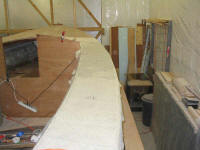 The next day, I repeated the process with the lighter cloth for the second
layer. The heavier biax cloth was 50" in width, while the lighter
cloth was 38". This allowed for a convenient overlap distance, so I
needed no special measures to provide for the overlap. The next day, I repeated the process with the lighter cloth for the second
layer. The heavier biax cloth was 50" in width, while the lighter
cloth was 38". This allowed for a convenient overlap distance, so I
needed no special measures to provide for the overlap. |
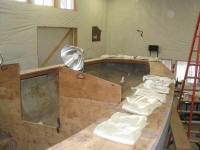 I had enlisted help for the fiberglassing day, mostly to assist with mixing
resin, fetching material or tools, and for additional help on some of the
larger pieces of cloth. To prepare for the big day, I spent the rest
of the afternoon cleaning the deck to remove any dust, organizing tools and fiberglass up on the deck for
convenience, and ensuring that all the resin, solvent, and other materials I
needed were in stock. I had enlisted help for the fiberglassing day, mostly to assist with mixing
resin, fetching material or tools, and for additional help on some of the
larger pieces of cloth. To prepare for the big day, I spent the rest
of the afternoon cleaning the deck to remove any dust, organizing tools and fiberglass up on the deck for
convenience, and ensuring that all the resin, solvent, and other materials I
needed were in stock. |
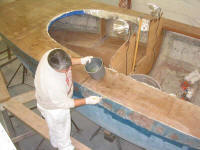 Fiberglassing
was a big job and took two of us about 3-1/2 hours to complete the entire
boat with both layers. We began at the stem with the first layer of
the heavier material, first by wetting out the plywood and sides of the hull
(where the material would overlap), and then laying the dry cloth
carefully over the top. For this project, I chose MAS low viscosity
resin and medium hardener. Fiberglassing
was a big job and took two of us about 3-1/2 hours to complete the entire
boat with both layers. We began at the stem with the first layer of
the heavier material, first by wetting out the plywood and sides of the hull
(where the material would overlap), and then laying the dry cloth
carefully over the top. For this project, I chose MAS low viscosity
resin and medium hardener.
|
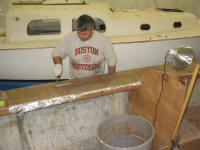 After
rolling the cloth into the resin beneath, we added more resin as needed to
completely wet out the piece. When it was completely saturated, we
rolled it out with air rollers, paying close attention to the deck surface
and the roundover where the material extended down onto the hull on each
side. After
rolling the cloth into the resin beneath, we added more resin as needed to
completely wet out the piece. When it was completely saturated, we
rolled it out with air rollers, paying close attention to the deck surface
and the roundover where the material extended down onto the hull on each
side. |
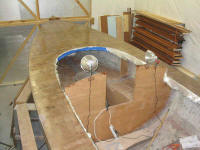 When
the first piece was complete, we could immediately add the second layer of
lighter cloth, since the light cloth was only 38" wide, while the heavier
cloth was 50". In this manner, we continued, applying both layers in
sequence. The first three pieces were the most difficult, as they
extended across the entire foredeck. If the boat had been any bigger
or wider, these pieces would have to have been ended at the centerline, as
they simply would have been too large to handle. As it was, we had no
time to relax, and kept working. I concentrated on positioning,
rolling, and air-rolling, while Nathan, my helper, mixed additional resin as
needed and assisted with rolling. When
the first piece was complete, we could immediately add the second layer of
lighter cloth, since the light cloth was only 38" wide, while the heavier
cloth was 50". In this manner, we continued, applying both layers in
sequence. The first three pieces were the most difficult, as they
extended across the entire foredeck. If the boat had been any bigger
or wider, these pieces would have to have been ended at the centerline, as
they simply would have been too large to handle. As it was, we had no
time to relax, and kept working. I concentrated on positioning,
rolling, and air-rolling, while Nathan, my helper, mixed additional resin as
needed and assisted with rolling. |
 Once
we completed the foredeck, the pieces shrank dramatically in size, making
the job easier. Alternating side to side, we continued down each
sidedeck to the transom. I let the fiberglass extend past the inside
edge of the carlins for later trimming. It was a messy and
tiresome job, but one completed with great success. I left the
material to cure overnight before continuing. Once
we completed the foredeck, the pieces shrank dramatically in size, making
the job easier. Alternating side to side, we continued down each
sidedeck to the transom. I let the fiberglass extend past the inside
edge of the carlins for later trimming. It was a messy and
tiresome job, but one completed with great success. I left the
material to cure overnight before continuing. |
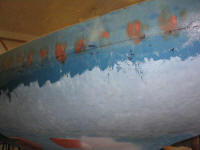 The
next day, the fiberglass was cured enough to begin sanding the surface.
First, however, I scrubbed the entire area with a Scotch-Brite pad and plain
water, in case any amine blush had formed on the surface. The product
description indicated that it was a low or no-blush resin, but it was better
to take no chances. The
next day, the fiberglass was cured enough to begin sanding the surface.
First, however, I scrubbed the entire area with a Scotch-Brite pad and plain
water, in case any amine blush had formed on the surface. The product
description indicated that it was a low or no-blush resin, but it was better
to take no chances. |
|
 When
the washing was complete, and the surface dried, I commenced sanding to
roughen the surface for later steps and remove any high spots. I used
80 grit sandpaper on a random orbit sander for this chore. Later, I
also sanded the overlapping fiberglass on the hull, and sanded away any
resin that had dripped down the hull; there was quite a bit in a few places,
particularly forward, where more substantial amounts of resin had been
needed in the cloth to get it to lay down properly on the hull. When
the washing was complete, and the surface dried, I commenced sanding to
roughen the surface for later steps and remove any high spots. I used
80 grit sandpaper on a random orbit sander for this chore. Later, I
also sanded the overlapping fiberglass on the hull, and sanded away any
resin that had dripped down the hull; there was quite a bit in a few places,
particularly forward, where more substantial amounts of resin had been
needed in the cloth to get it to lay down properly on the hull.
|
 The
new fiberglass stiffened the deck noticeably, though the decks had been
strong and nearly flex-free before, and would provide the decks with the
requisite watertight integrity. The
new fiberglass stiffened the deck noticeably, though the decks had been
strong and nearly flex-free before, and would provide the decks with the
requisite watertight integrity.Next:
Fairing and final preparations.
|
|
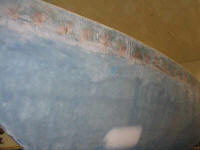
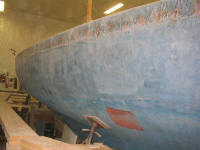
|
|
